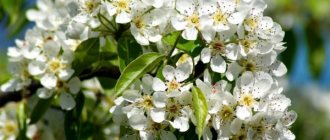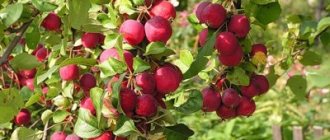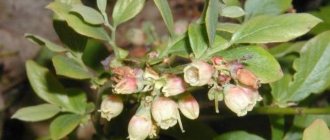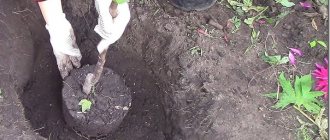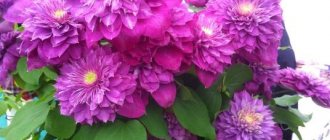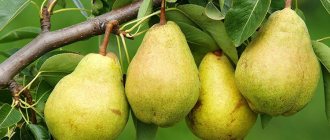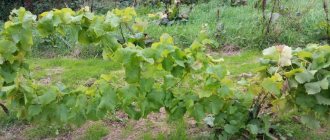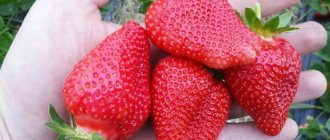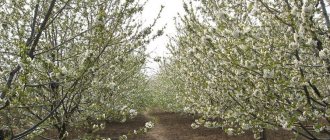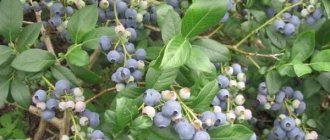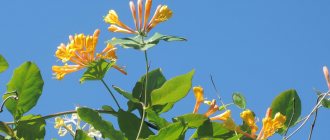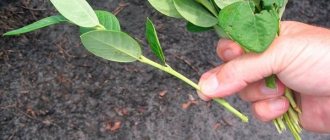The edible honeycomb apple tree has been known since ancient times. There is no person on earth who has not heard the story of Adam and Eve. And it all started with an apple. Today, humanity knows many different varieties. But there are no limits to perfection: people continue to experiment, cultivate them and breed more and more new species. We will talk about one of them - the Venyaminovsky apple, a description and photo of which is presented below.
Apple tree Venyaminovskoe.
What type does it belong to?
The Venyaminovskoe apple tree is a winter variety . The main indication for storage: avoid cool temperatures at which the fruits may wilt.
The shelf life of apples is up to five months.
Winter apple varieties also include: Bellefleur Bashkirsky, Belorusskaya Malinovaya, Bolotovsky, Nastenka and Winter Beauty.
Description of the Venyaminovsky variety
The apple tree of this variety is of not only industrial, but also aesthetic interest.
Apple trees of the Venyaminovskoye variety are quite large , reaching a height of one and a half meters. The crown grows round in shape and has an average density.
The branches form a right angle with the trunk, and then their ends are directed upward, quite strong and large. The bark of the tree is smooth to the touch and has a gray tint.
The shoots of the apple tree have a curved shape in the form of an arc. The covering is fleecy, and when cut, they are dark red in color. The buds also have a fleecy surface and are cone-shaped.
The leaves are oval in shape, curled towards the top in the form of a screw, wavy along the edges, slightly jagged.
The color is dark green, the surface is smooth, there are large veins, slightly pubescent.
The flowers are pale pink, rounded in shape, the inflorescences contain six flowers.
Benjamin apples are medium in size - reaching a maximum of 130 grams. However, there are cases when the apple tree bore large fruits, reaching 300 grams.
The shape of apples resembles a beveled cone, rounded on the sides. When the apples reach the harvesting period, they have a greenish tint, and when they reach the period suitable for consumption, the color of the fruit takes on a more yellowish tint.
Most of the surfaces of apples are covered with a scarlet blush . If the fruit ripens under better lighting, then the cover is almost completely covered in scarlet color. On the fruits you can easily notice grayish subcutaneous dots.
Apple trees of the following varieties can also boast of special beauty: Seedling Solntsedara, Nymph, Oryol Pioneer, Fragrant and Ekranny.
The taste of apples is of the dessert, sweet and sour type. The pulp of the fruit is juicy, white, sometimes has a greenish tint. The chemical composition of the apple contains an abundance of healthy acids and vitamins.
| Compound | Quantity |
| Sahara | 8,6% |
| Titratable acids | 0,71% |
| Ascorbic acids | 4.5 mg/100 g |
| Vitamin P | 222 mg/100 g |
additional characteristics
The Venyaminovskoye apple tree variety has distinctive features that should be taken into account when choosing this apple tree for your garden.
Peculiarities
The variety stands out:
- Immunity to scab;
- Abundant regular fruiting;
- Excellent taste and good transportability of apples;
- Winter hardiness, ability to quickly recover after freezing.
Among the disadvantages are:
- Small fruit size;
- Extension of the maturation period;
- To produce a harvest, the variety needs pollinators.
Tree height
The official description indicates the maximum height of an adult tree on seed rootstocks - 5 meters , on low-growing ones - up to 3.5.
Apple tree Venyaminovskoe.
ATTENTION! Practicing gardeners indicate that the apple tree grows up to 7 meters on vigorous growing ones, and up to 5 meters on dwarf rootstocks.
Annual growth
The annual growth is 0.5 m, the figure does not decrease even after an unfavorable wintering.
Productivity
In the first years , 30-50 kg of apples are harvested from one tree . A twelve-year-old apple tree already produces up to 100 kg of fruit , or 15 tons per hectare.
Tasting assessment
Venyaminovskoe is distinguished by a harmonious sweet and sour dessert taste, delicate aroma and pleasant juiciness.
Tasting rating according to various sources - 4.4 or 4.5 on a 5-point scale.
The variety is recommended for dietary and baby food.
Winter hardiness
When testing the variety at low temperatures, slight (0.9 points) damage to the wood was noted. Venyaminovskoe showed resistance to frosts of -40 degrees.
In winter, when for several days the temperature dropped to -45, and often to -40, gardeners noted freezing of the fruit part of the wood. Subsequently, the damaged trees recovered normally, growth was 50 cm per year, fruiting resumed within 2-3 years.
Disease resistance
The variety is absolutely resistant to scab thanks to the Vf gene.
Lifespan of a tree
Venyaminovskoye is a young variety. However, taking into account the complex of properties, experts call the lifespan of an apple tree to be 50-70 years on a seed rootstock, and up to 30 years on a low-growing one.
The Venyaminovskoye apple tree lives up to 70 years.
Photo
History of selection
The year of the first fruiting of the Venyaminovsky variety is considered to be 1990 . In 1981, seeds were selected from open-pollinated harvests of that year, and in 1982 the first sowing was carried out.
Developed at the Russian Research Institute for Breeding Fruit Crops, in 1995 it was recognized as an elite variety .
The breeders who were involved in the cultivation and breeding of this variety are Serova Z.M., Dolmatov E.A., Zhdanov V.V. and others. The varieties Orlovsky striped and Aphrodite are also considered elite
Productivity
This variety is famous for its record rich yield.
For comparison: trees whose age ranges from 8 to 11 years brought 150 centners per hectare , while the Antonovka variety brings only 95 under the same conditions.
The consumer properties of the fruit last from mid-October to February. The disadvantages of this variety are considered to be non-simultaneous ripening and high fruit shedding.
The following varieties are also distinguished by high yields: Uralsky bulk, Phoenix Altai, Lobo, Isetsky late and Dachny.
How to properly care
Let's consider the basic principles of caring for the Zhigulevskoye apple tree.
This procedure is extremely important for the apple tree, especially in dry, hot weather. A young tree should be watered more often, an adult tree less often.
It is recommended that after watering, mulch the soil with humus or peat; the layer should be approximately 7 cm. In addition, after watering, loosen the soil in the tree trunk circle to ensure good air exchange for the tree roots.
This procedure is carried out annually, starting when the seedling reaches one year of age after planting. So, every spring it is necessary to carefully inspect the tree and remove old, dried branches - this is the so-called sanitary pruning. In addition, in order for the buds to quickly recover from winter and begin to bloom, in the spring the shoots are shortened by about a third.
Attention: use high-quality and sharp garden tools for pruning to minimize damage to the tree.
The Zhigulevskoye apple tree most of all needs fertilizers containing nitrogen, since this substance activates all vegetative processes in the plant. However, do not forget that nitrogen can be applied only in the spring, and in the fall it is forbidden under any circumstances.
In summer, it is recommended to feed the tree with copper sulfate or also nitrogenous compounds.
Planting and care
This variety has its own characteristics in planting and care.
This variety can be planted both in autumn and spring. But the preferred time is early. Before planting a seedling of the Venyaminovkoye variety, the most important thing is to properly prepare the soil.
It must be enriched with nutrients, and it must also have good water and breathability.
The tree is highly sensitive to nearby groundwater, so in such cases artificial drainage of the soil is necessary. The place should be well lit.
A dug hole, about 70 centimeters deep and a meter in diameter, must be filled to the top, until a mound is formed, only with the top layer of dug soil, having first mixed it with humus or any other fertilizers.
The mound is necessary so that the seedling does not “sag” over time; you can monitor the degree of soil compaction after the hole is dug for a month, and only then begin planting.
The bottom layer of soil is simply scattered around or between the rows.
TIP: If the soil is clayey, its depth needs to be increased, and the bottom should be strewn with old cans, sawdust or stones to provide air access to the tree's root system.
The seedling must be planted at a certain height - at ground level, neither lower nor higher. The seedling should be tied to a peg, which is previously installed in the hill, in a figure eight.
It is advisable that two people be involved in planting a seedling, then the process will be faster and of better quality.
In order to remain satisfied with the harvest of apple trees each year, they need to be provided with proper care on a regular basis. The harvest will be rich every year if you fertilize the apple trees in a timely and gradual manner.
start feeding the tree in spring . Ammonium nitrate in a dose of thirty or forty grams is suitable for this After the tree begins to bear fruit, it will need to be fertilized with humus or fresh manure.
As a phosphorus-potassium fertilizer, you can use ash , which is poured into a bucket with fertilizer. For each tree you need two or three of these buckets.
It is important to ensure that the soil remains sufficiently loose all year round , then the roots will be provided with a sufficient amount of air.
to trim old branches every spring , remove unsightly bark, then such pruning will provide you with an increase in productivity.
ATTENTION! This variety is resistant to rejuvenating or shaping pruning.
Problems during cultivation
Since the variety is very resistant to apple diseases, and resistance to the most formidable disease - scab - is determined at the genetic level, the main threat to Venyaminovsky apple trees comes from insect pests.
Amateur gardeners recommend using natural raw materials in pest control. Infusions of wormwood, hot pepper, onion peels, and ash (used both individually and in mixtures with each other) are sprayed onto trees.
Aphids are the main pest of apple orchards and do not tolerate the influence of calendula, cilantro and dill growing near the trees. Tansy growing around trees prevents the appearance of most harmful insects.
The following chemicals are used:
- Copper sulfate is used for medicinal and prophylactic purposes during the formation of flower buds.
- "Karbofos", Bordeaux mixture - apply according to the instructions before flowering.
- "Fozalon", solution 4% - is used, following the instructions for the drug, during the period of fruit formation.
- Urea is used to treat plants during the fruiting period.
Did you know? Apples do not sink in water because they are 25% air.
The preparations allow you to effectively fight not only aphids, but also codling moths, codling moths, hawthorn and fruit sapwood. Before the onset of winter, fallen leaves, carrion, and insect nests are removed from the site.
